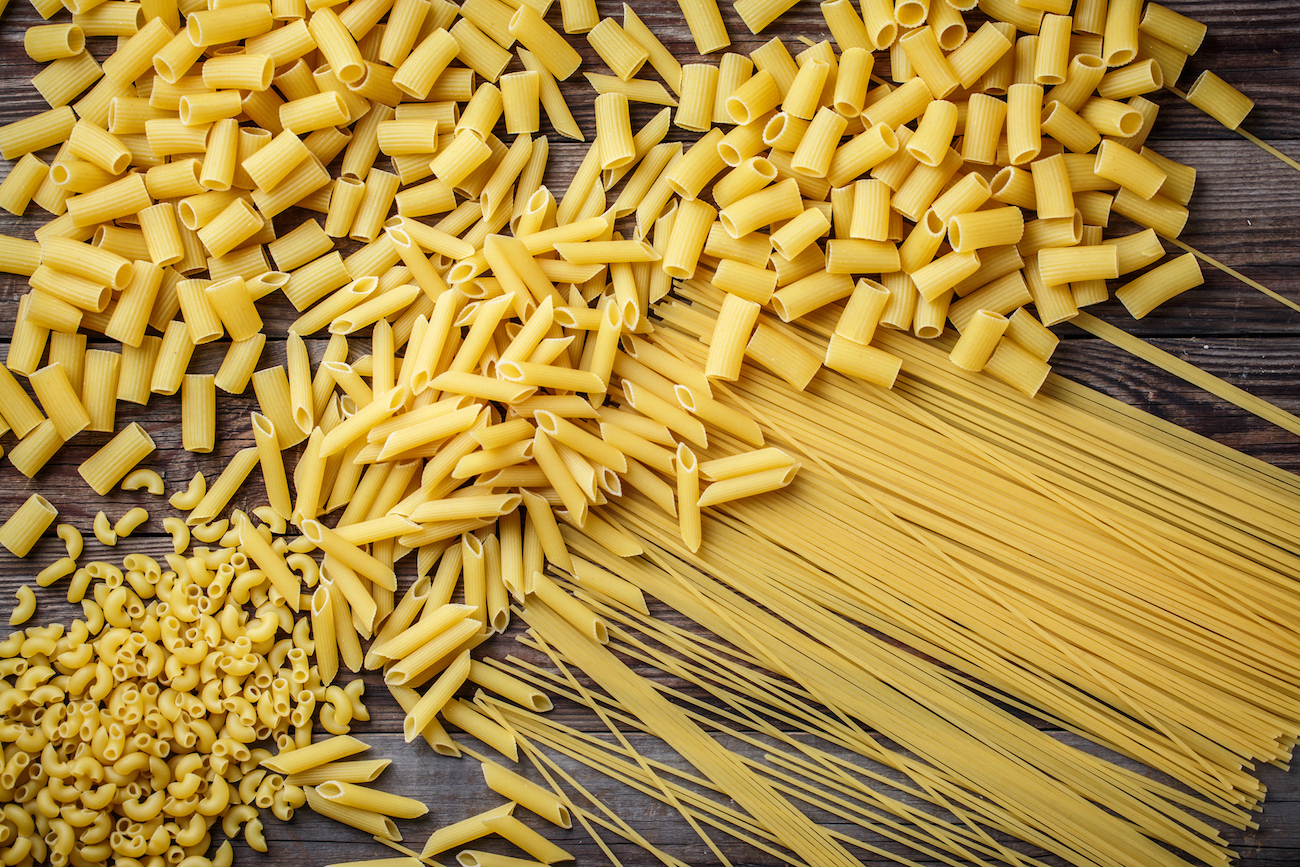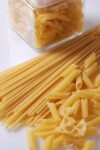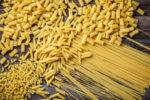
Pasta Introduced to the U. S. (With Recipes)
Thomas Jefferson was the US Minister to France from 1785-1789 and enjoyed the many pasta dishes served there. He brought back macaroni and other noodle recipes, plus a pasta machine. When he became president, he served macaroni and cheese at an 1802 state dinner. Macaroni was sold in long tubes, then broken into smaller pieces when ready to cook.
Kraft Foods introduced its boxed macaroni and cheese in 1937, during the Great Depression. With rationing in effect during World War II, the boxed mix was popular since fresh meat and dairy were in short supply. (source)
INFORMATION BELOW FROM 1800s COOKBOOKS
MACARONI
Macaroni is a product of wheat prepared from a hard, clean, glutenous grain. The grain is ground into a meal called semolina, from which the bran is excluded. This is made into a tasty dough by mixing with hot water in the proportion of two-thirds semolina to one-third water. The dough, after being thoroughly mixed is put into a shallow vat and kneaded and rolled by machinery. When well rolled, it is made to assume varying shapes by being forced by a powerful plunger through the perforated head of strong steel or iron cylinders arranged above a fire. The dough is partially baked as it issues from the holes and afterwards hung over rods or laid upon frames covered with cloth, and dried. It is called by different names according to its shape. If in the shape of large, hollow cylinders, it is macaroni; if smaller in diameter, it is spaghetti; if fine, vermicelli; and if the paste is cut into fancy patterns, it is termed pasta d’Italia.
Macaroni was formerly made only in Italy, but at present is manufactured to a considerable extent in the United States. The product, however, is in general greatly inferior to that imported from Italy, owing to the difference in the character of the wheat from which it is made.The Italian macaroni is produced from a hard, semi-translucent wheat, rich in nitrogenous elements, and which is only grown successfully in a hot climate. Like all cereal foods, macaroni should be kept in a perfectly dry storeroom.
Macaroni serves as an important adjunct to the making of various soups and also forms the basis of other palatable dishes.
TO SELECT MACARONI
Good macaroni will keep in good condition for years. It is rough, elastic, and hard, while the inferior article is smooth, soft, breaks easily, and becomes moldy with keeping. Inferior macaroni contains a large percentage of starch, and but a small amount of gluten. When put into hot water, it assumes a white, pasty appearance, and splits in cooking. Good macaroni, when put into hot water, absorbs a portion of the water, swells to nearly double its size, but perfectly retains its shape. Inferior macaroni is usually sold a few cents cheaper per pound than the genuine article. The best quality of any shape one pleases can be bought in most markets for ten or fifteen cents a pound.
TO PREPARE AND COOK MACARONI
Do not wash macaroni. If dusty, wipe with a clean, dry cloth. Break into pieces of convenient size. Always put it to cook in boiling liquid, taking care to have plenty of water in the saucepan (as it absorbs a large quantity), and cook until tender. The fluid used for cooking may be water, milk, or a mixture of both; also soup stock, tomato juice, or any preferred liquid. The length of time required for cooking may vary from twenty minutes if fresh, and to one hour if stale. When tender, turn into a colander, drain, and pour cold water through it to prevent the tubes from sticking together.
MACARONI WITH CREAM SAUCE
Put macaroni into boiling water and cook until tender. When done, drain thoroughly, then add a pint of milk, part cream if it can be afforded, a little salt and one well-beaten egg. Stir over the fire until it thickens. Serve with a cream sauce prepared by heating a pint of rich milk* to boiling, in a double boiler. When boiling, add a heaping tablespoon of flour, rubbed smoothed in a little milk, and one-fourth teaspoon of salt. If desired, the sauce may be flavored by a slice of onion or a few bits of celery, steeping it in the milk before thickening for ten or fifteen minutes, and then removing with a fork. Serve hot.
*rich milk – one-fourth to one-third cream.
MACARONI WITH TOMATO SAUCE
Break a dozen sticks of macaroni into two-inch lengths, and drop into equal parts of boiling milk and water. Let it boil for an hour or until perfectly tender. In the meantime, prepare the sauce by rubbing a pint of stewed or canned tomatoes through a colander to remove all seeds and fragments. Heat to boiling, and thicken with a little flour; a tablespoon to the pint will be about the requisite proportion. Add salt and if desired, one-half cup of very thin sweet cream. Dish the macaroni into individual dishes, and serve with a small quantity of the sauce poured over each dish.
MACARONI BAKED WITH GRANOLA
Break macaroni into pieces about an inch in length sufficient to fill a large cup, and cook until tender in boiling milk and water. When done, drain and put a layer of the macaroni in the bottom of an earthen pudding dish, and sprinkle over it a scant teaspoon of granola. Add a second and third layer and sprinkle each with granola. Then pour over the whole a custard sauce prepared by mixing together a pint of milk, the well-beaten yolks of two eggs or one whole egg, and one-fourth teaspoon of salt. Care should be taken to arrange the macaroni in layers loosely, so that the sauce will readily permeate the whole. Bake for a few minutes only, until the custard has well set, and serve.
EGGS AND MACARONI
Break fifteen whole sticks of macaroni into two-inch lengths, and put to cook in boiling water. While the macaroni is cooking, boil four eggs until the yolks are mealy. When the macaroni is done, drain, and put a layer of it arranged loosely in the bottom of an earthen pudding dish. Slice the cooked egg yolks and spread a layer of them over the macaroni. Fill the dish with alternate layers of macaroni and egg, taking care to have the top layer of macaroni.
Pour over the whole a cream sauce prepared as follows: Heat one and three-fourths cup of rich milk to boiling, then add one-fourth teaspoon of salt and one heaping spoon of flour rubbed smooth in a little cold milk. Cook until thickened, then pour over the macaroni. Sprinkle the top with grated bread crumbs, and brown in a hot oven for eight or ten minutes. Serve hot.
HOME-MADE MACARONI
To four cups of flour, add one egg well beaten, and enough water to make a dough that can be rolled. Roll thin on a breadboard and cut into strips, then dry in the sun. The best arrangement for this purpose is a wooden frame to which a square of cheese-cloth has been tightly tacked. The macaroni may be laid in such a way as not to touch, and afterwards covered with a cheese-cloth to keep off the dust during the drying.
Image from Deposit Photos
=================================================
Making Artisan Pasta
Learn how to use the best ingredients and simple, classic techniques to make fresh, homemade pasta in your own kitchen with Making Artisan Pasta. Calling for just the simplest ingredients and a handful of unique kitchen tools, making pasta at home has never been easier, more fun, or more delicious.
Inside, you’ll find:
– Recipes for pasta doughs made completely from scratch, with such delicious ingredients as buckwheat and whole wheat flour, roasted red pepper, asparagus, and even squid ink and chocolate
– Fully illustrated step-by-step instructions for rolling, shaping, and stuffing dough for gnocchi, lasagna, cannelloni, pappardelle, tagliatelle, ravioli, and dozens of other styles of pasta.
=================================================
Do You Love Macaroni and Other Pastas? Please Leave a Comment Below.
=================================================


